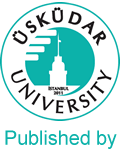Years
2019
2017
Categories
Authors
ARTICLES
Case Report
Two cases of schizophrenia: the relationship between cavum septum pellucidum and clinical course
Turkish Title : İki şizofreni vakası: klinik gidiş ile cavum septum pellucidum ilişkisi
Yusuf Ezel Yıldırım,Engin Sert,Pınar Çetinay Aydın,Tonguc Demir Berkol,Sevilay Kunt
JNBS, 2019, 6(1), p:67-69
Septum pellucidum, which forms the medial wall of the lateral ventricles, consists of two laminates. Cavum septum pellucidum (CSP) is defined when there is a space between these laminae. In some MRI studies have shown a higher rate of large CSP in patients with schizophrenia than in normal subjects. Looking at the literature on psychiatric disorders, CSP has been shown to be most associated with schizophrenia. Large CSP supports the neurodevelopmental model, which is one of the etiological explanations of schizophrenia. In our study, two patients with a diagnosis of CSP are mentioned. One of our patients is a first episode of schizophrenia, and the other one chronic schizophrenia patient with a history of multi-drug resistance. The first episode of schizophrenia is consistent with the information available in the literature in terms of the severity of symptoms, weak-response to treatment, and insufficiency of neuropsychological tests. The apparent deficit of the chronic schizophrenia patient suggests that CSP has a neurodevelopmental model in the etiology of schizophrenia, as well as the duration of the disease and non-compliance with treatment. There is no study in the literature comparing the response to treatment with large CSP in schizophrenia. It is thought that investigation of response to treatment in future studies is important for demonstrating the effects of neurodevelopmental model on the treatment of psychiatric disorders.
Lateral ventriküllerin medial duvarını oluşturan septum pellucidum iki laminadan oluşmaktadır. Bu laminalar arasında boşluk oluştuğunda Cavum septum pellusidum (CSP) olarak tanımlanmaktadır. Bazı MR çalışmalarında, şizofreni tanılı hastalarda normal kişilerden daha yüksek oranda geniş CSP saptanmıştır. Psikiyatrik bozukluklarla ilgili literatüre bakıldığında CSP’un en çok şizofreni ile bağlantılı olduğu gösterilmiştir. Geniş CSP şizofreninin etiyolojik açıklamalarından biri olan nörogelişimsel modeli desteklemektedir. Çalışmamızda CSP tanısı olan iki olgudan bahsedilmektedir. Hastalarımızdan biri ilk episod şizofreni olup, diğeri geçmişte çok ilaca direnç öyküsü olan bir kronik şizofreni hastasıdır. İlk edisod şizofreni olgumuzun belirtilerin şiddeti, tedaviye yanıtsızlık ve nöropsikolojik testlerdeki yetersizlik açısından literatürde mevcut olan bilgilerle uyuşmaktadır. Kronik şizofreni olgumuzun yıkımının belirgin olması hastalık süresi ve tedavi uyumsuzluğunun yanında CSP’nin şizofreninin etiyolojisindeki nörogelişimsel modeli düşündürmektedir. Şizofrenide geniş CSP ile literatürde tedaviye yanıtın karşılaştırıldığı bir araştırmaya rastlanmamıştır. İlerideki araştırmalarda tedaviye yanıtın araştırılması nörogelişimsel modelin psikiyatrik bozuklukların tedavisindeki etkilerinin gösterilebilmesi için önemli olduğu düşünülmektedir.
Case Report
Electroconvulsive therapy in schizophrenia with coincidental choroidal fissure cyst: A case report
Turkish Title : Şizofreni ve rastlantisal koroid fissür kisti birlikteliğinde elektrokonvulsif tedavi: olgu sunumu
Yasin Hasan Balcioglu,Tonguc Demir Berkol,Filiz Ekim Cevik,Fatih Oncu,Guliz Ozgen
JNBS, 2017, 4(3), p:134-137
Choroidal fissure cyst (CFC), an intracranial space-occupying mass, is often incidentally identified and generally regarded not to present with overt clinical signs. The concurrence of space-occupying lesions with psychotic disorders have been reported in numerous cases; however, to the best of our knowledge, co-occurrent CFC and schizophrenia have not been published before in the literature. Electroconvulsive therapy (ECT) has been frequently considered relatively contraindicated in patients with spaceoccupying lesions in the brain; nevertheless, in the last few years, increased numbers of studies encourage clinicians to treat drugresistant psychiatric patients with ECT. Here we present 21-year-old male patient, who has been diagnosed with antipsychoticresistant schizophrenia with a coincidental CFC who have been clinically improved by bilateral and modified nine sessions of ECT. It is recommended to be deliberate if ECT will be applied to the patients with intracranial mass on the treatment phase. ECT may cause some side effects by increasing intracranial pressure on the patients, including rupture of cystic lesions. However, recent publications stated that ECT could be used safely in cysts, which do not cause edema or intracranial pressure increase. Our patient has not been presented any intracranial pressure signs nor neurological deficits. This report supports the safety and efficacy of ECT in the treatment of psychiatric disorders accompanied by intracranial structural lesions; nevertheless, all the risks ought to be taken into account cautiously when ECT becomes an issue for the psychiatric patients with intracranial mass and the opinion of neurosurgeons should be taken with calculating the benefit-loss ratio.
Koroid fissür kisti (KFK) çoğunlukla rastlantısal saptanan ve belirgin klinik belirtilerle seyretmediği kabul edilen bir kafa içi yer kaplayan lezyondur. Yer kaplayıcı lezyonlar ile psikotik bozuklukların birlikteliği birçok çalışmada bildirilmiş olsa da KFK ve şizofreni birlikteliğinin literatürde gösterilmemiş olduğu dikkat çekmektedir. Elektrokonvulsif tedavi (EKT) kafa içi yer kaplayıcı lezyonu olan hastalarda sıklıkla rölatif kontraendike olarak kabul edilse de son yıllardaki çalışmalar bu lezyonların olduğu ve tedaviye dirençli psikiyatrik hastalarda EKT kullanımını cesaretlendirmektedir. Yazımızda 21 yaşında, tedaviye dirençli şizofreni tanısı almış, rastlantısal olarak KFK saptanan ve 9 seans bilateral ve modifiye EKT uygulanması sonucu klinik iyileşme izlenen bir hasta sunulmuştur. Kafa içi yer kaplayıcı lezyonların varlığında EKT uygulanırken temkinli yaklaşılması önerilmektedir. EKT kafa içi basıncı arttırarak bu lezyonların rüptüre olmasına neden olabilir. Ancak son yayınlar belirgin ödem veya kafa içi basınç artışı bulgusu olmayan vakalarda EKT’nin güvenle kullanılabileceğini desteklemektedir. Vakamızda herhangi bir kafa içi basınç artışı bulgusu veya nörolojik defisit bulunmamaktaydı ve bu nedenle EKT tercih edildi. Bu olgu sunumu, kafa içi yapısal lezyonu olan psikiyatrik hastalarda EKT’nin etkin ve güvenilir bir biçimde kullanılabileceğine dair kanıt sunmayı amaçlamıştır. Ancak bu durumda tüm risklerin varlığı göz önünde bulundurularak nöroşirurjiyenlerin görüşleri alınmalı ve kar-zarar hesabı yapılarak son karar verilmelidir.
| ISSN (Print) | 2149-1909 |
| ISSN (Online) | 2148-4325 |
2020 Ağustos ayından itibaren yalnızca İngilizce yayın kabul edilmektedir.


